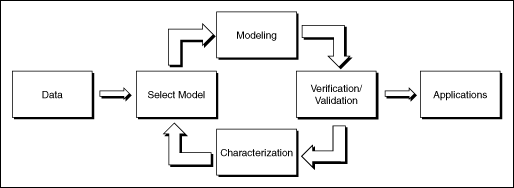Model-Based Control Design Process (System Identification Toolkit)
The model-based control design process involves building a model of a plant, analyzing and synthesizing a controller for the plant, simulating the plant and controller, and deploying the controller. National Instruments provides a complete solution for identifying and validating a dynamic system model, designing a controller for the model, analyzing the controller, and prototyping and deploying the control system. The following figure shows this process, which is based on LabVIEW and National Instruments Real-Time (RT) Series hardware.

Analyzing Data and Creating a Dynamic System Model
In the initial phase of the design process, you must obtain a mathematical model of the plant you want to control. One way to obtain a model is by using a numerical process known as system identification. This process involves acquiring data from a plant and then numerically analyzing stimulus and response data to estimate the parameters of the plant.
National Instruments provides DAQ and modular instrumentation software and hardware that you can use to stimulate and measure the response of the plant. You then can use the System Identification Toolkit to estimate and create accurate mathematical models of the plant.
System identification is a process that includes acquiring and preprocessing raw data from a real-world system and identifying mathematical models based on the raw data. You then validate that the resulting model accurately describes the observed system behavior. If the results are unsatisfactory, you revise the parameters and iterate through the process. The following flowchart shows a typical system identification process.

A real-world system seldom has one model that perfectly describes all the observed behaviors of the system. Because system identification involves many variables—such as sampling frequency, type of mathematical model, model order, and so on—you usually have a number of models you can use. Each model describes the behavior of the system to some extent or in a particular mode of operation.
Furthermore, multiple applicable algorithms might be available for the same model. The algorithms you select depend on the model structure, stochastic assumptions, and numerical properties of the algorithm. The System Identification Toolkit includes different adaptive techniques for recursive system identification and different algorithms for model estimation.
Designing a Controller
In the second phase of the design process, you synthesize and analyze a controller. The LabVIEW Control Design and Simulation Module provides a set of VIs for classical and modern linear control analysis and design techniques. With these VIs you can design, implement, and deploy linear time-invariant (LTI) system models.
You can use the Control Design and Simulation Module to analyze the plant model you identified with the System Identification Toolkit. The Control Design and Simulation VIs help you determine an appropriate controller structure. You then can synthesize a controller to achieve the desired performance criteria of the system based on the dynamic behavior of the plant and/or control system. Finally, you can analyze the overall system by combining the controller with the identified plant model.
Simulating the Dynamic System
In the third phase of the design process, you simulate the dynamic system. You can simulate dynamic systems in LabVIEW by using the Control Design and Simulation Module. You can use this software to perform offline simulations of a linear or nonlinear dynamic system model. You can use this simulation to investigate the time and frequency responses of the dynamic system due to complex, time-varying inputs. If you install the LabVIEW Real-Time Module, you also can perform rapid control prototyping (RCP), and hardware-in-the-loop (HIL) simulations by using NI RT Series hardware.
Deploying the Controller
The last stage of the design process is to deploy the controller to an RT target, such as a PXI or CompactRIO controller. LabVIEW, the Control Design and Simulation Module, the RT Module, and NI RT Series hardware provide a common platform that you can use to design, prototype, and deploy the embedded control system. You also can use the Control Design and Simulation Module and the Real-Time Module as the platform for implementing the control system.
National Instruments also provides products for I/O and signal conditioning, such as NI DAQ and SCXI devices, that you can use to gather and process data. Using these tools, which are built on the LabVIEW platform, you can experiment with different approaches at each stage in the design process and quickly identify the optimal design solution for an embedded control system.
Refer to the National Instruments Web site at ni.com for more information about these National Instruments products.